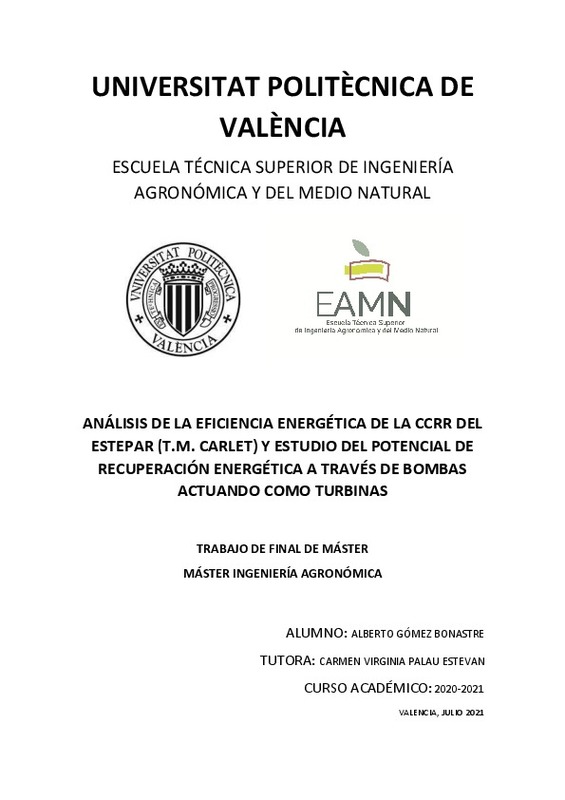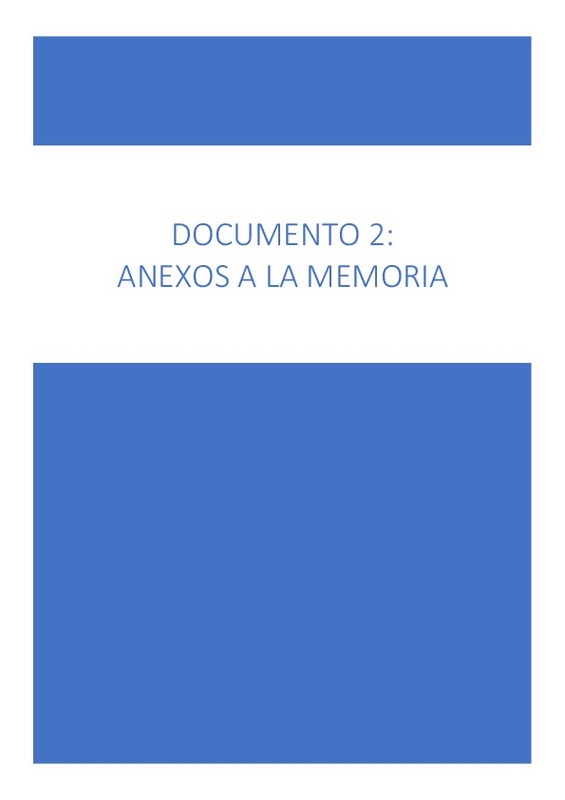|
Resumen:
|
[ES] El objetivo del presente Trabajo de Final de Máster es la búsqueda de la optimización en la gestión de redes de riego, tanto desde el punto de vista del consumo hídrico para regadío como del consumo energético para ...[+]
[ES] El objetivo del presente Trabajo de Final de Máster es la búsqueda de la optimización en la gestión de redes de riego, tanto desde el punto de vista del consumo hídrico para regadío como del consumo energético para el funcionamiento de la red.
Para ello, se analiza y estudia un caso concreto, el de la Comunidad de Regantes (CC.RR.) del Estepar, perteneciente al Término Municipal de Carlet. Además, se buscará cuantificar la energía recuperable en ciertos puntos de la instalación bajo diversas hipótesis de funcionamiento empleando bombas actuando como turbinas (Pump As a Turbine, PAT).
En este contexto, la CC.RR. gestiona el aporte hídrico de aproximadamente 400 hectáreas de cultivos frutales, fundamentalmente cítricos y caquis, para lo cuál cuenta con todas las infraestructuras requeridas para su funcionamiento, destacando: dos balsas de regulación, dos cabezales de riego, un centenar de hidrantes multiusuario componiendo 3 subredes de riego, dos elementos de impulsión (una desde el canal Júcar-Túria y otra desde un pozo), conducciones a presión y elementos de control, regulación y automatización. Además, la topografía de la zona es variable lo que favorece la generación de sobrepresiones en la red recuperables, la dominancia de dos cultivos homogeneiza la demanda y, por ende, la organización del riego a lo largo del año.
Para llevar a cabo el estudio, se emplearán aplicaciones informáticas que permitan recopilar la información referente a la topografía de las parcelas y la red en cuestión, destacando el programa de visualización y edición geográfica QGis y el programa de análisis de redes Epanet 2.0. Conocidas las condiciones actuales, se propondrán diferentes hipótesis de funcionamiento de la red de riego, para cada una de las cuales se estudiará la posibilidad de introducir las PAT para cuantificar la posible energía recuperable, manteniendo unas condiciones óptimas de funcionamiento.
Finalmente, se aportarán una serie de medidas de mejora y ahorro energético para la futura gestión de la CC.RR., relacionadas con el manejo de la instalación, así como con la optimización de las tarifas eléctricas. Todo ello permitirá concluir sobre la capacidad de mejora de la CC.RR. en el manejo y gestión del regadío, mostrando la viabilidad de las PAT como tecnología innovadora en redes de gran calibre para el ahorro energético y económico.
[-]
[EN] The aim of this Master's thesis is the search for efficiency in the management of irrigation networks, both from the point of view of water consumption for irrigation and energy consumption and for the operation of ...[+]
[EN] The aim of this Master's thesis is the search for efficiency in the management of irrigation networks, both from the point of view of water consumption for irrigation and energy consumption and for the operation of the network.
To this end, a specific case is analysed and studied. Specifically, the Water Use Association (CC.RR.) of Estepar, belonging to the Municipal District of Carlet (Valencia, Spain). In addition, the aim is to quantify the energy recovery at certain points of the installation under different operating hypotheses using pumps acting as turbines (PAT).
In this context, the CC.RR. manages the water supply for approximately 400 hectares of fruit crops, mainly citrus and persimmon, for which it has all the infrastructures required for its operation, including: two regulation reservoirs, two irrigation heads, a hundred multi-user hydrants making up 3 irrigation sub-networks, two impulsion elements (one from the Júcar-Túria canal and the other from a well), pressure pipes and control, regulation and automation elements. In addition, the topography of the area is variable, which facilitates the generation of recoverable overpressures in the network. Finally, the dominance of two crops homogenises the demand, therefore the organisation of irrigation throughout the year too.
To carry out the study, computer applications will be used to compile information on the topography of the plots and the network, particularly the QGis geographic visualisation and editing programme and the Epanet 2.0 network analysis programme. Once the current conditions are known, different operating hypotheses for the irrigation network will be proposed, for each of which the possibility of introducing PATs will be studied to quantify the possible energy recovery, maintaining optimal operating conditions.
Finally, a list of improvements and energy saving measures will be provided for the future management of the CC.RR., related to the management of the installation, as well as for the optimisation of electricity tariffs. All of this will allow us to conclude on the capacity for improvement of the CC.RR. in the management of irrigation, showing the viability of the PAT as an innovative technology in large-scale networks for energy and economic savings.
[-]
|








